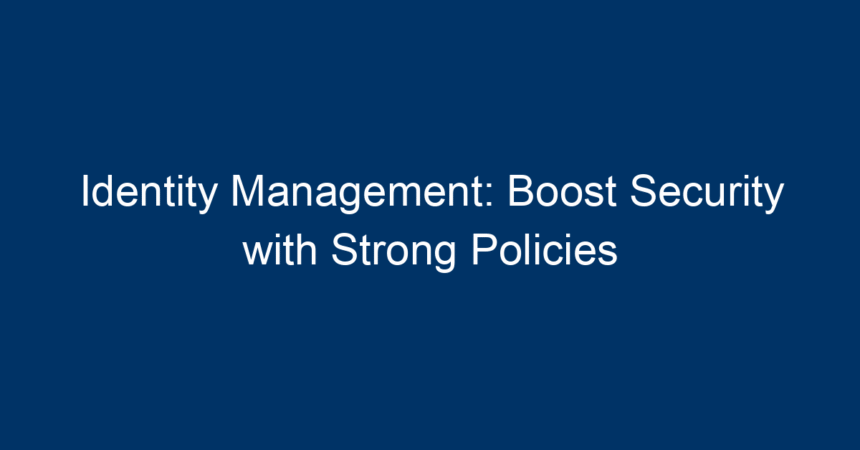In today’s digital landscape, identity management has emerged as a cornerstone of robust security strategies. With the rapid increase in cyber threats, ensuring that only authorized users can access sensitive information is crucial for any organization. In this article, we’ll delve into the intricacies of identity management, explore its significance, discuss essential policies for effective implementation, address common challenges, and provide actionable insights to enhance your security posture.
Understanding Identity Management
What is Identity Management?
Identity management (IdM) refers to the comprehensive processes and technologies used to manage digital identities. This includes everything from user authentication to access control, ensuring that only the right individuals can access the right resources at the right times. It encompasses a variety of functions, including:
- User Provisioning: The creation, modification, and deletion of user accounts.
- Authentication: Verifying the identity of users through various methods.
- Authorization: Determining what resources a user can access once authenticated.
The Importance of Identity Management
The primary objective of identity management is to enhance security while improving user experience. When implemented effectively, businesses can:
- Protect Sensitive Data: Prevent unauthorized access to confidential information.
- Improve Compliance: Meet regulatory requirements and standards such as GDPR, HIPAA, and others.
- Streamline Operations: Ensure that users have the access they need without delays.
Key Policies for Effective Identity Management
For a robust identity management framework, establishing strong policies is essential. Here are several critical policies to consider:
1. Access Control Policy
An access control policy defines who can access specific resources and under what conditions. This policy should include:
- Role-Based Access Control (RBAC): Assign access permissions based on user roles, minimizing exposure to sensitive data.
- Least Privilege: Grant users the minimal level of access required to perform their job functions.
2. Password Management Policy
Strong passwords are the first line of defense against unauthorized access. A password management policy should enforce:
- Complexity Requirements: Require passwords to be a mix of letters, numbers, and symbols.
- Regular Updates: Mandate periodic password changes to reduce the risk of breaches.
3. Multi-Factor Authentication (MFA) Policy
Implementing MFA adds an additional layer of security by requiring users to provide two or more verification methods. Ensure your policy includes:
- Supported Authentication Methods: Use methods like SMS, email, biometrics, or authentication apps.
- Specific Scenarios for MFA: Enforce MFA for accessing sensitive data or from unfamiliar devices or locations.
4. User Lifecycle Management Policy
Managing user identities throughout their employment lifecycle is essential. This includes:
- Onboarding Procedures: Create accounts with appropriate permissions based on job functions.
- Offboarding Procedures: Ensure accounts are promptly disabled when employees leave the organization to prevent unauthorized access.
5. Security Awareness Training Policy
A well-informed workforce plays a crucial role in identity management. Implement a training policy that includes:
- Regular Training Sessions: Educate employees on recognizing phishing attempts and other cyber threats.
- Best Practices: Promote the importance of strong passwords, the use of MFA, and reporting suspicious activities.
Common Challenges in Identity Management
Despite its importance, several challenges can hinder effective identity management. Here are a few that many organizations face:
1. Complexity of Systems
Many organizations use various applications and systems, making centralized identity management complex. A unified identity platform can help simplify management and improve security.
2. Resistance to Change
Employees may resist new identity management strategies, especially if they complicate processes. Change management strategies, including communication and training, can help ease this transition.
3. Compliance Issues
Staying compliant with evolving regulations can be daunting. Regular audits and updates to policies are vital to ensure compliance and avoid severe penalties.
Implementing Strong Identity Management Policies
1. Assess Your Current Infrastructure
Before implementing new identity management policies, assess your current infrastructure to identify vulnerabilities and areas for improvement.
2. Choose the Right Tools
Investing in robust identity management solutions is essential. Look for technologies that offer:
- Automation: Streamlines user onboarding and offboarding.
- Reporting: Provides insights into user activity and access patterns.
3. Involve Stakeholders
Engage stakeholders from various departments to create policies that meet the diverse needs of your organization. This inclusivity ensures smoother implementation and better user buy-in.
Conclusion: Enhance Security with Strong Identity Management Policies
In conclusion, identity management is crucial for securing sensitive information and ensuring compliance with regulatory standards. By establishing strong policies covering access control, password management, multi-factor authentication, and user lifecycle management, organizations can significantly boost their security posture. While challenges exist, they can be mitigated through careful planning, robust tools, and employee engagement.
Actionable Insights:
- Conduct Regular Security Audits: Regularly assess your identity management practices to identify areas for improvement.
- Emphasize User Training: Continuously educate employees on the importance of identity management and cybersecurity threats.
- Stay Updated on Regulations: Keep abreast of changing compliance requirements to ensure your policies remain effective and compliant.
By prioritizing identity management and implementing strong policies, your organization can proactively safeguard against threats, enhancing both security and overall operational efficiency.




